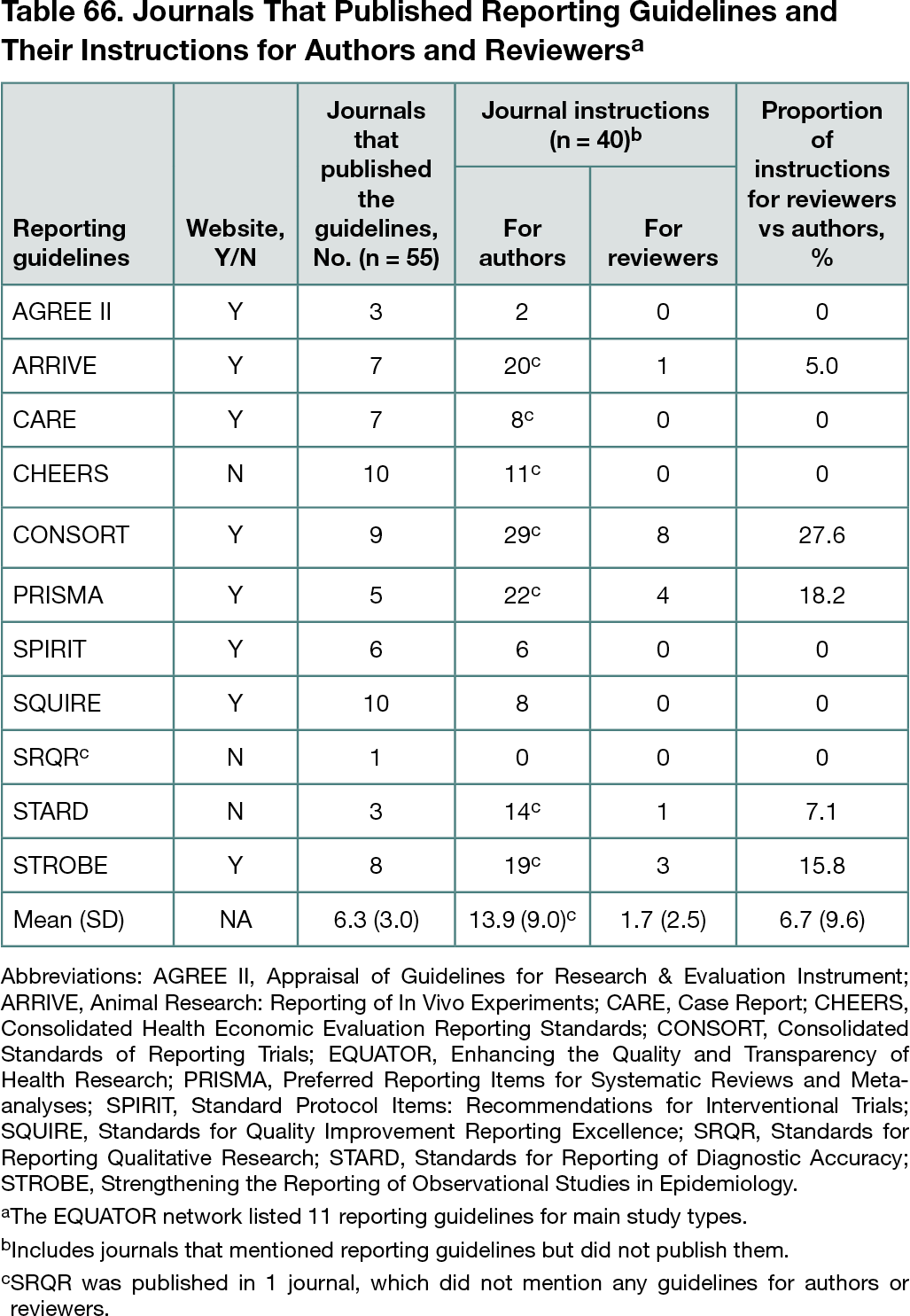Abstract
Analysis of Biomedical Journals’ Instructions to Authors and Reviewers on Use of Reporting Guidelines
Peiling Wang,1 Dietmar Wolfram2
Objective
Reporting guidelines for biomedical publications have been developed for more than 2 decades. The extent of their appropriate use by authors has varied across journals.1,2 Researchers found varied instructions for authors following the Standards for Reporting of Diagnostic Accuracy (STARD) reporting guideline across journals.3 To improve the quality of biomedical publications, it is important to bridge the gaps in adopting and implementing reporting guidelines. This study investigated which biomedical journals published the current major reporting guidelines and how they instructed authors and reviewers to adhere to the reporting guidelines.
Design
Data were collected between May 2021 and June 2021 from the Enhancing the Quality and Transparency of Health Research (EQUATOR) network, the Reporting Guidelines websites (eg, http://www.consort-statement.org/ and https://prisma-statement.org//), journals that published the guidelines, and journals’ instructions for authors and reviewers. From the 11 EQUATOR network–listed guidelines for main study types, there were 8 available guideline websites and 55 journals that published 1 or more current reporting guidelines. Additional data were collected from the 55 journals regarding endorsement of the specific guidelines and the journal’s instructions for authors and reviewers, respectively. The data excluded instructions that only mentioned EQUATOR.
Results
The journals that endorsed specific guidelines ranged from 24 for Standards for Quality Improvement Reporting Excellence (SQUIRE) reporting guideline–friendly journals to 1047 for Animal Research: Reporting of In Vivo Experiments (ARRIVE). However, only 55 journals published 1 to 10 guidelines (mean [SD], 6.3 [3.0]) (Table 66). Some journals published specific guidelines but did not give instructions regarding these guidelines; other journals did not publish specific guidelines but included them in instructions for authors and reviewers. Of the 55 journals, 40 (72.7%) provided instructions for authors, mentioning between 1 and 8 guidelines. Only 9 journals (16.4%) instructed reviewers about 5 guidelines. The guidelines in instructions for authors occurred more in open access journals (median, 5) than non–open access journals (median, 2). The collaborations among guidelines showed that the same contributors were involved in the development of multiple guidelines. For example, the Strengthening the Reporting of Observational Studies in Epidemiology (STROBE) reporting guideline website referenced the Consolidated Standards of Reporting Trials (CONSORT) reporting guideline, SQUIRE, and STARD. The level of implementation of adopted guidelines also varied by journal: answering yes or no questions about a relevant guideline, requiring authors to attach a guideline checklist, or citing guidelines.
Conclusions
There is varied adoption and implementation of published guidelines by medical journals. Open access journals that published guidelines were more likely to instruct authors about the guidelines. The varied levels of instructions for authors and almost no instructions for reviewers on adherence to reporting guidelines call for further study. It should be of concern if a journal publishes reporting guidelines but does not instruct authors to adhere to the guidelines. Both authors and reviewers can contribute to improving the quality of biomedical research publications through adherence to established reporting guidelines.
References
1. Caulley L, Catalá-López F, Whelan J, et al. Reporting guidelines of health research studies are frequently used inappropriately. J Clin Epidemiol. 2020;122:87-94. doi:10.1016/j.jclinepi.2020.03.006
2. Caulley L, Cheng W, Catalá-López F, et al. Citation impact was highly variable for reporting guidelines of health research: a citation analysis. J Clin Epidemiol. 2020;127:96-104. doi:10.1016/j.jclinepi.2020.07.013
3. Smidt N, Overbeke J, de Vet H, Bossuyt P. Endorsement of the STARD Statement by biomedical journals: survey of instructions for authors. Clin Chem. 2007;53(11):1983-1985. doi:10.1373/clinchem.2007.090167
1School of Information Sciences, University of Tennessee–Knoxville, Knoxville, TN, USA, peilingw@utk.edu; 2School of Information Studies, University of Wisconsin–Milwaukee, Milwaukee, WI, USA
Conflict of Interest Disclosures
None reported.
Additional Information
Dietmar Wolfram is a co–corresponding author.

